The December 2009 Daring Bakers challenge was brought to you by Anna of Very Small Anna and Y of Lemonpi. They chose to challenge Daring Bakers everywhere to bake and assemble a gingerbread house from scratch. They chose recipes from Good Housekeeping and from The Great Scandinavian Baking Book as the challenge recipes.
We’ve been making gingerbread houses for years, since the now-very-nearly-18-year-old #1 Son (hereafter known as Alex) was a wee lad. We started out with the standard cottage, but there’s a limit to how many years in a row we could do that. We’re, um, quirky around here.
Over the past 15 years or so we’ve made a haunted tower, a ruined castle (the year we tried a new recipe and it didn’t work), a spaceship, a sunken pirate ship, the chocolate room from Willy Wonka (my personal favorite), Stonehenge, and a fairy-tale cottage with a torture chamber in the basement. Last year it was a goblin dungeon (courtesy of the boys; parental discretion advised). The tradition is that we decide on the structure together, then I figure out how to make it happen, and they decorate it. Works for me.
We started discussing this year’s house (er, structure) in November, and we tossed around a lot of ideas. And then Alex got into Duke University, and our lives began to revolve around his future alma mater.
At Duke, all freshmen live on East Campus, a lovely collection of Georgian buildings built along a long, narrow green. It’s lovely. So I thought, “Hey, let’s make East Campus!”

Foolish, foolish woman.
Let’s just say that this looked very different in my head. I wanted to make the whole green: eight identical buildings with two different ones in the middle, plus a round auditorium at the end. Plus, every year during orientation the new freshman class gets together for a photo of their graduation year.

I’d do that too!
Well, scale’s a bitch. That’s a huge green, let me tell you. I spent days gathering photographs and taking measurements in Google Earth. (Did you know there’s a ruler in Google Earth? It’s awesome for obsessive-compulsives like me.)
And then I started drawing and realized it was impossible.
I would have needed a five-foot-long board to do it to the smallest scale I thought was feasible for building the houses. That’s just silly. And there are supposed to be trees, but the cones we bought to make the trees are about 50 percent taller than the buildings. (Please don’t ask why I had to keep it to scale. Please.)
So, regroup. I went with the six center buildings, which is four of the identical ones plus the Lilly Library and the Marketplace. I drew templates. I baked pieces, just a few, to test the recipes (more on that later).
And then I realized that there was no way I could do the fancy roofline on such a small scale. It just wasn’t going to happen.
Regroup again. Two-story buildings instead of three. (See how calm I’m staying? Breathe in, breathe out.)
And then those freshman making numbers? (You can buy baby gummy bears now!) Didn’t fit in the center circle. I punted yet again.
So here you have it. I did what I could. The construction is not up to our usual standards. There’s not much room for decoration. And the gingerbread doesn’t taste all that good. But Alex got into Duke, and that’s all that matters.
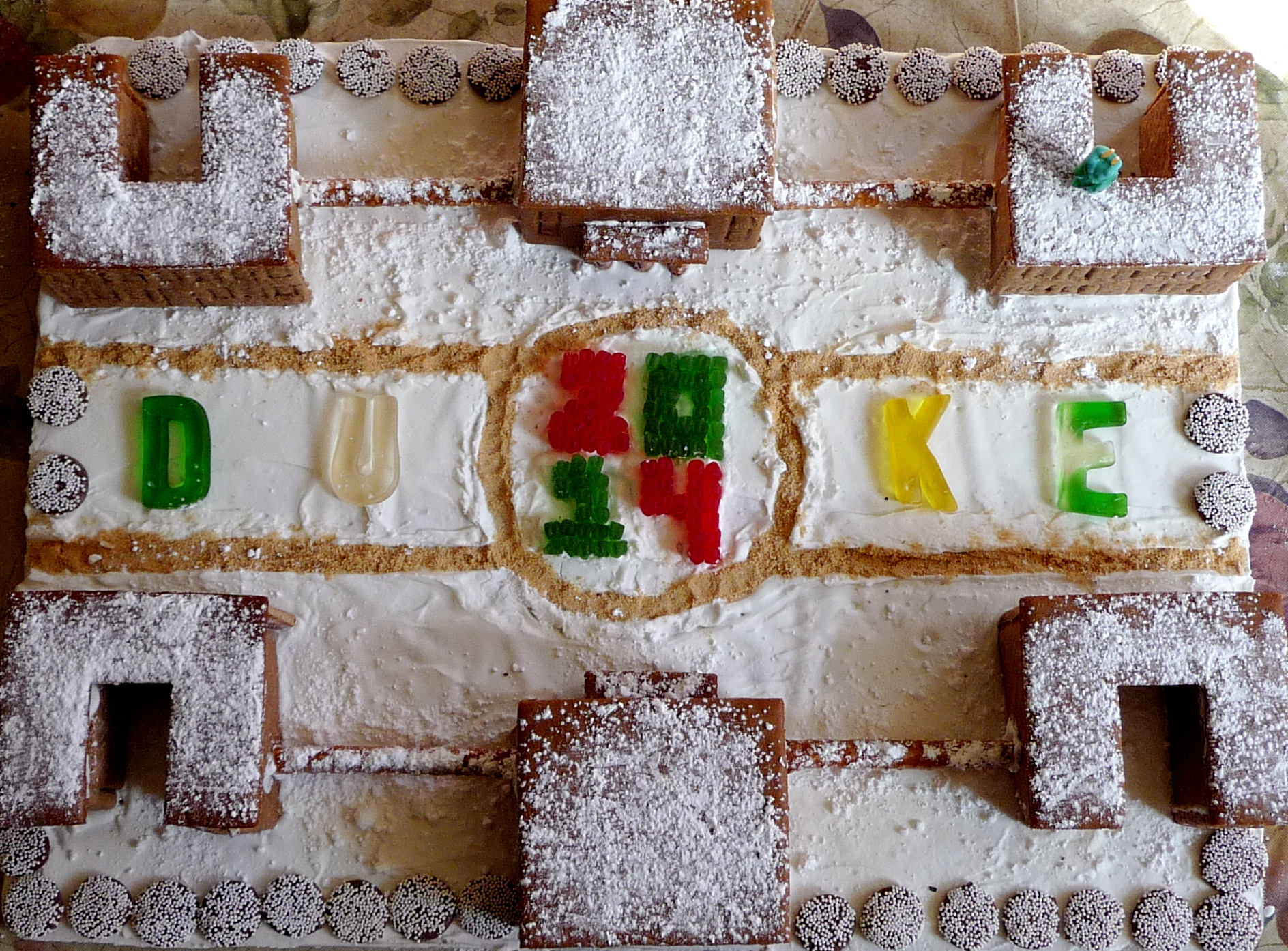
After it was built, I let the boys decorate it. Alex added snow on the building and a lovely nonpareil border, plus a Blue Devil up there on the roof. Sadly, it took me so long to get this whole thing done that we’d eaten most of the candy we bought for it, so it’s a minimalist house this year. But it’s ours, and Alex got into Duke. We are very happy.
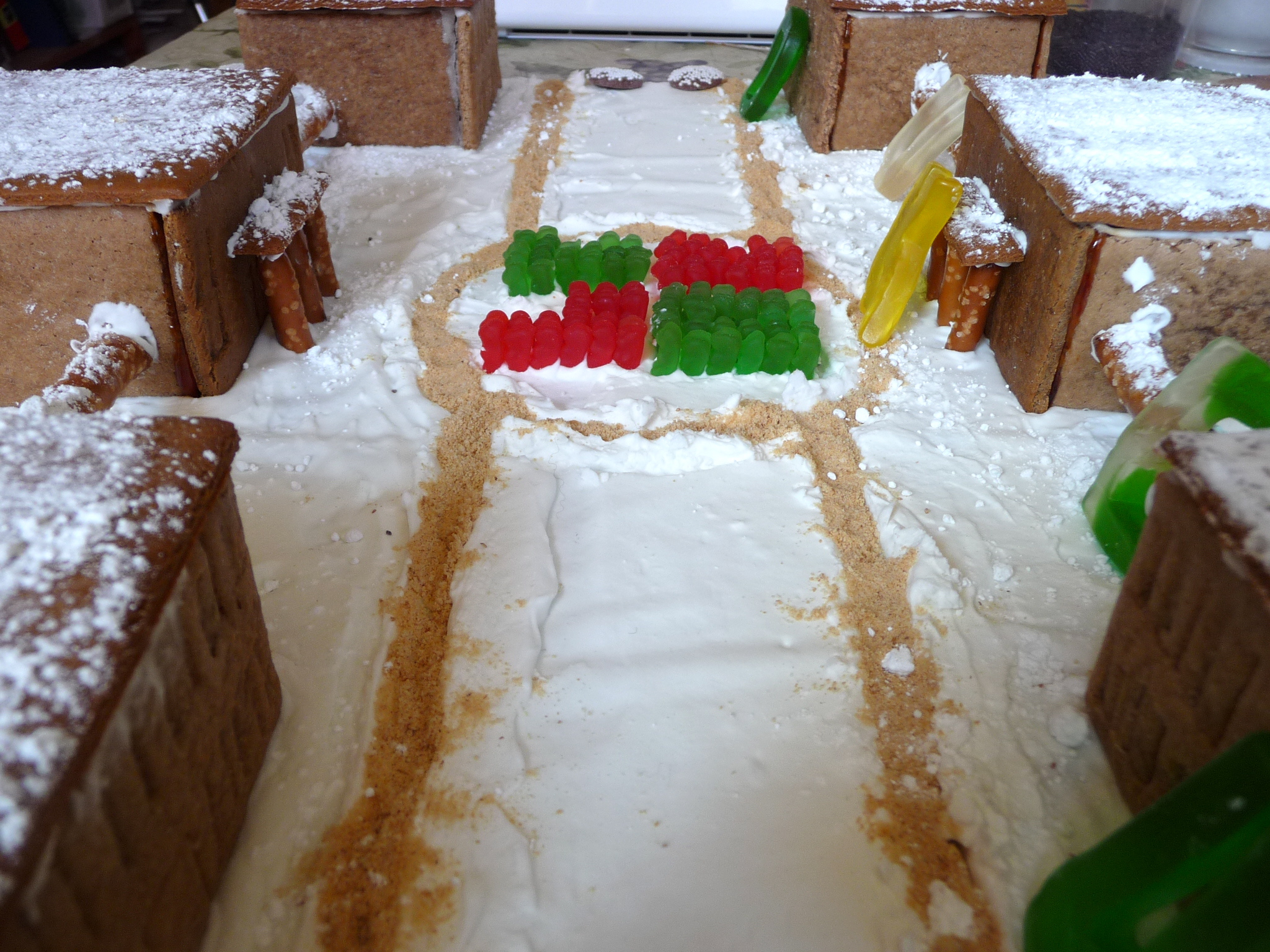
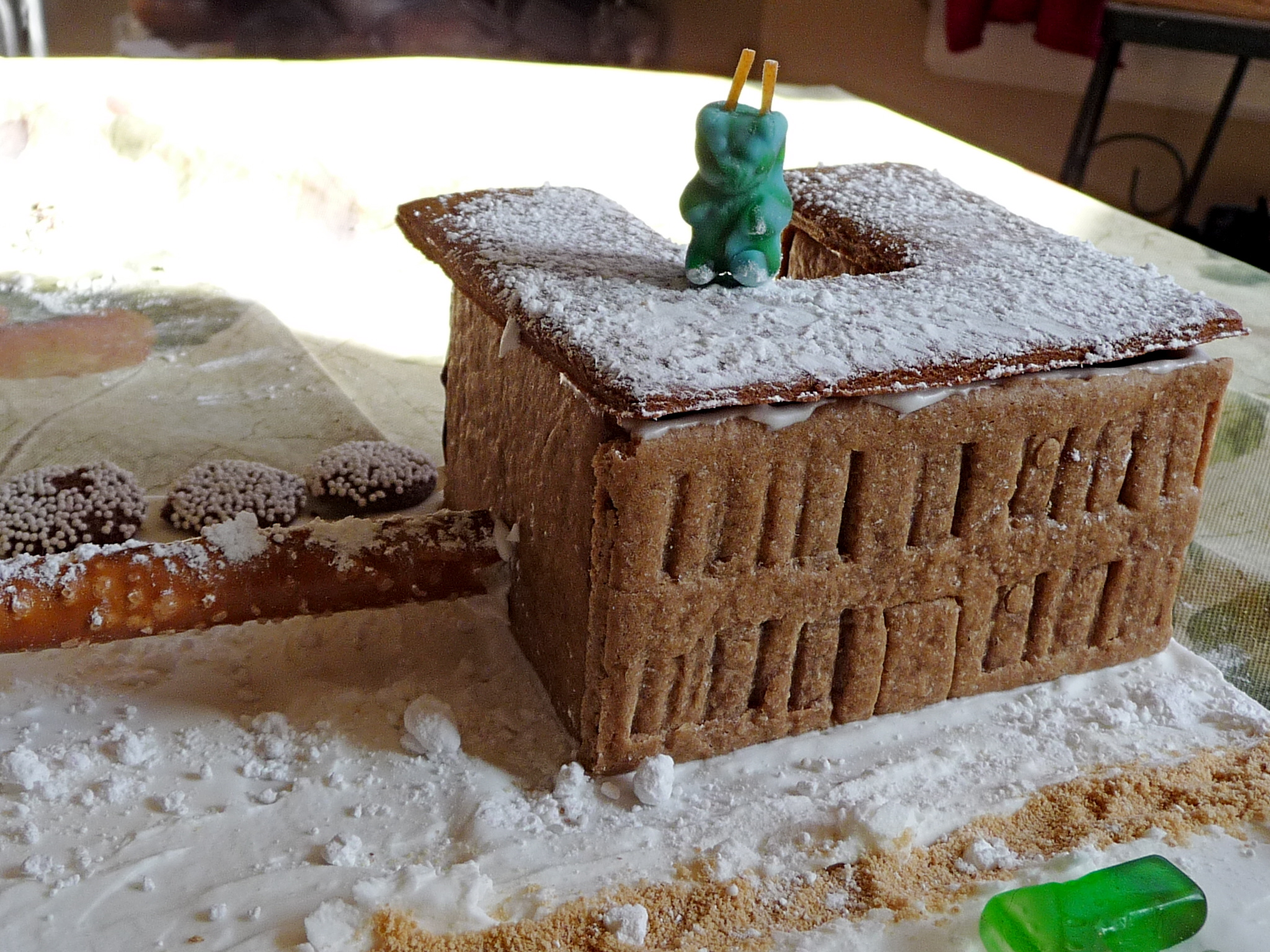
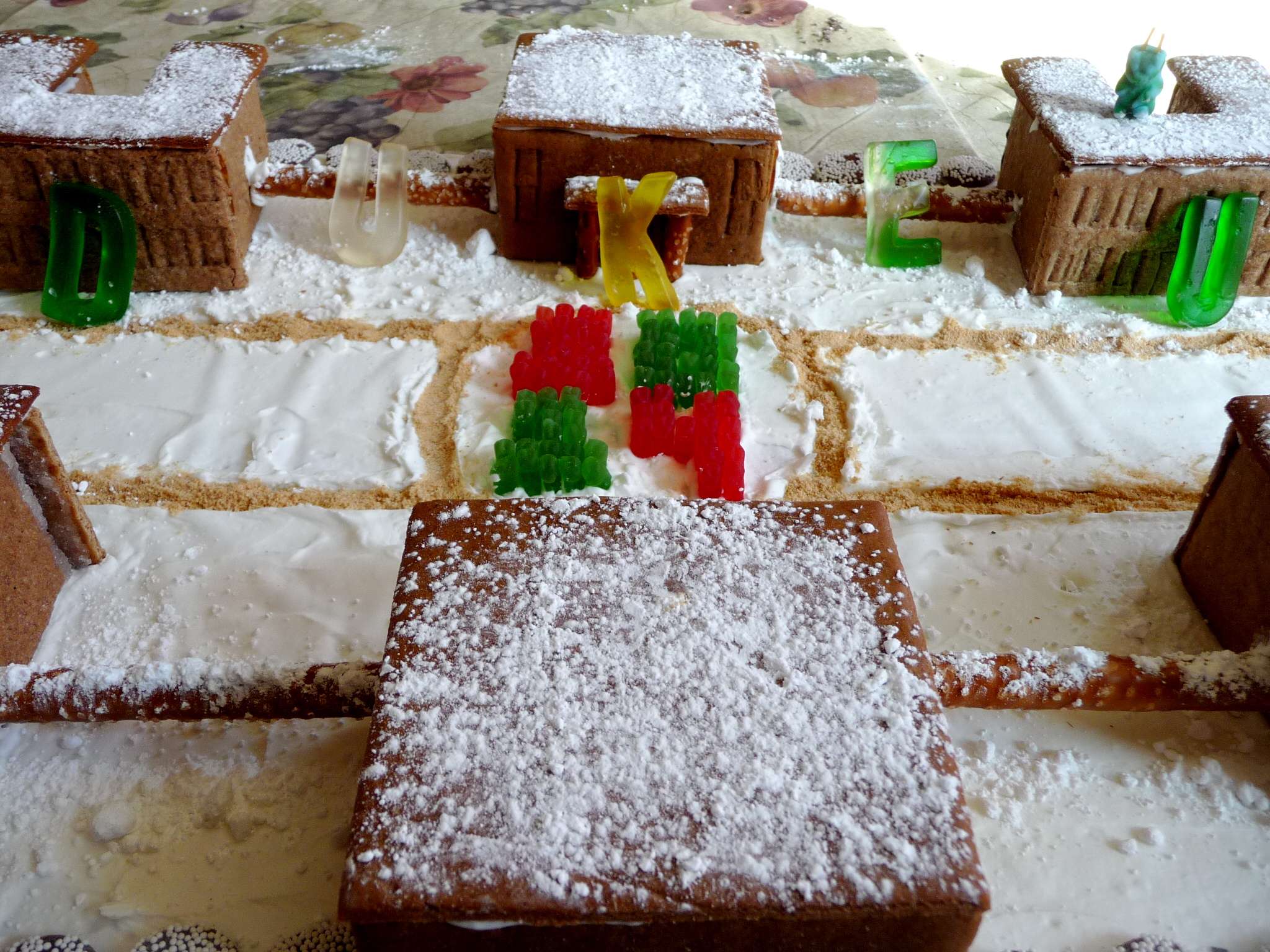
So, this month’s challenge offered a choice of two doughs, one very simple and the other a bit more complex. I made both, just to see. Both of them (Anna’s dough, from Good Housekeeping, and Y’s dough, a more traditional Scandinavian recipe) mixed fine (although I left out the baking soda and used much less flour than they called for, because a lot of the Daring Bakers had trouble with the doughs being too dry; the recipes below have the amounts I used). They rolled out fine. They baked fine. But they didn’t look all that good as finished pieces, and they don’t taste like much.
For years I’ve used Teresa Layman’s recipe from her amazing Gingerbread for All Seasons (sadly out of print and insanely expensive used; check your library!). If you want to see the amazing things that can at least theoretically be done by normal people, check out that book. I’ve learned a lot of techniques from it over the years, but I couldn’t make anything near as gorgeous as she does. Her recipe bakes up flat and pretty and builds lovely structures, and it tastes pretty good (especially with royal icing on it!).
And it lasts — I found some of last year’s dough in the back of my freezer, thawed it out, and baked it up.
So the six buildings in our little tableau are made up of pieces made of three different doughs. All the roofs are Teresa Layman’s dough; see how pretty they are?
(Oh, and speaking of roofs, wanna hear a funny story? I built one of those little C-shaped buildings and very carefully measured it, so I could make the roof template. I very carefully drew the template (using a T-square!). I very carefully cut out the template. I very carefully baked the pieces. I very carefully cooled the pieces. I very carefully laid a roof on top of my finished building. And I discovered that I had somehow — very carefully, no doubt — cut my lovely C into a T. Isn’t that funny?)
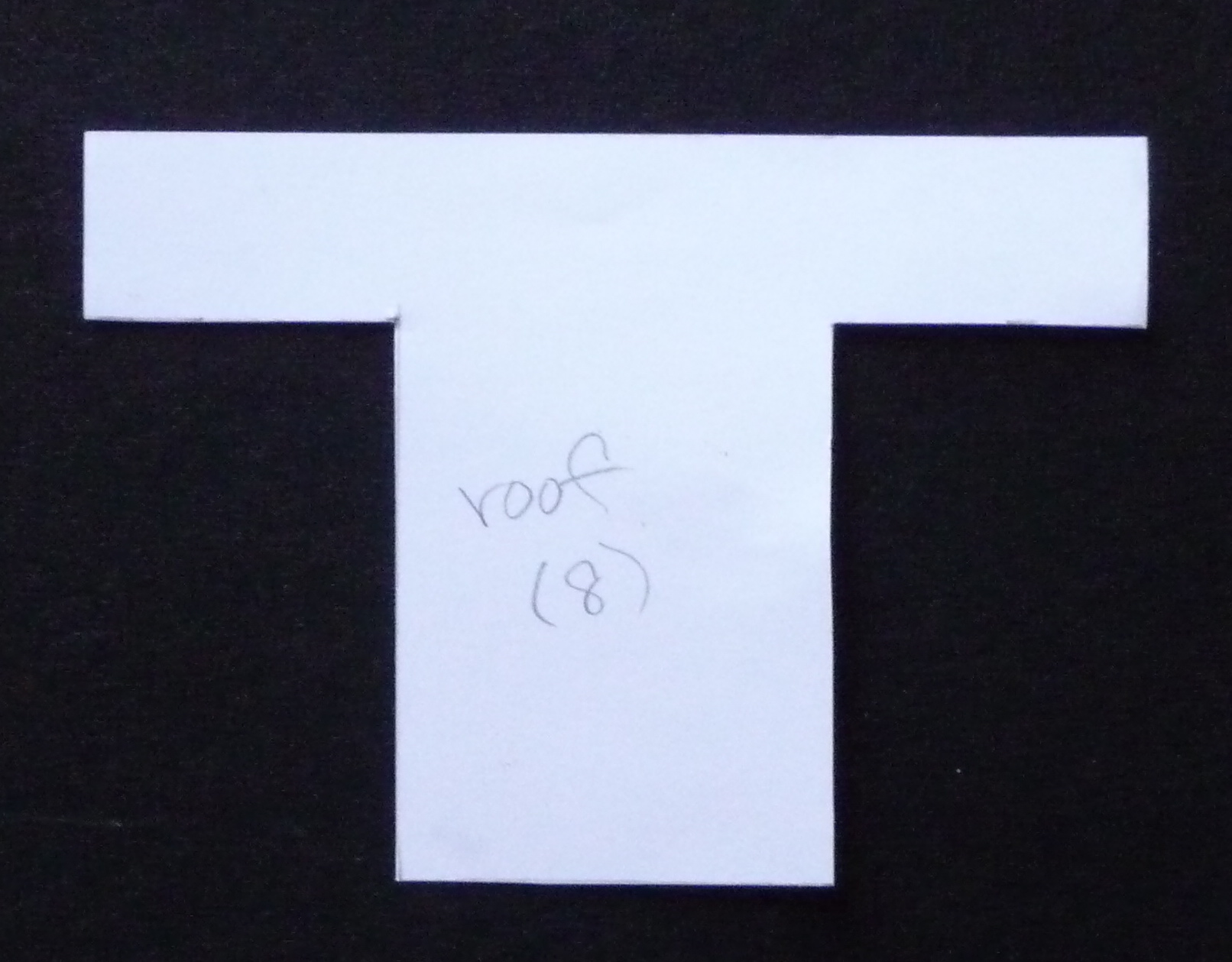
The recipes below include a sugar syrup for putting the houses together. I loved this idea; it seemed so much neater than having to pipe royal icing along all the walls. I cannot tell you how much sugar I wasted trying to get this to work. My first test batch seemed OK, and held the walls together nicely until my husband, marveling at how secure they were, picked up the building and waved it around; they were not that secure. So I tried again. I tried melting the sugar dry. I tried adding a little water, remembering some recipe I once read that said that adding a little water made it easier to melt sugar without burning it. And I did use the sugar syrup to put the walls together. But I could only get a few walls out of each batch before it became too burned or too crystalized, and I added quite a few new specimens to my collection of scars. So next year, it’s back to the icing.
Oh, and here’s the rest of my template, as actually used:
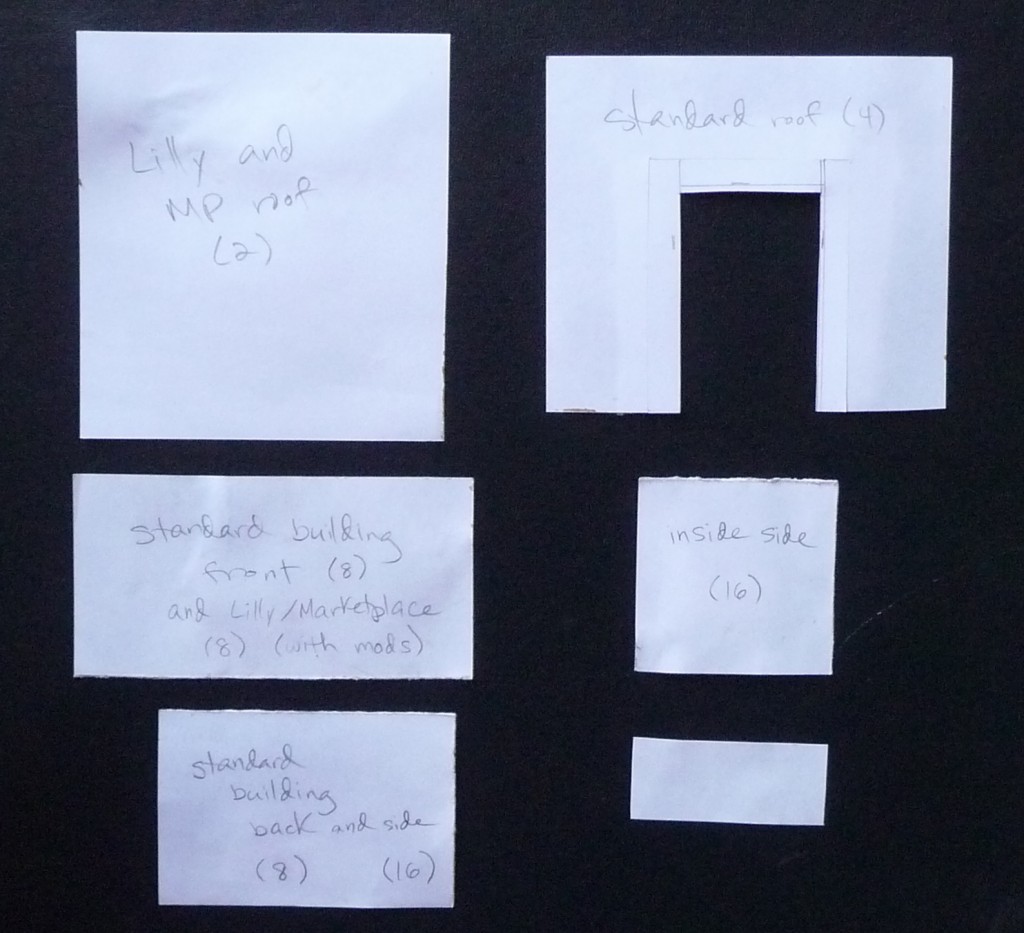
Update: Within minutes of my taking those photos above, the campus was gone, demolished by two growing boys and their unfortunately growing father. We didn’t have a party to take it to this year, so this was a purely private achievement— except for all of you!
So, with no further ado, the recipes:
Anna’s Recipe:
Spicy Gingerbread Dough (from Good Housekeeping)
2½ cups (500g) packed dark brown sugar
1½ cups (360mL) heavy cream or whipping cream
1¼ cups (425g) molasses or maple syrup
9½ cups (1140g) all-purpose flour
1 tablespoon(s) ground ginger
Directions
1. In very large bowl, with wire whisk (or with an electric mixer), beat brown sugar, cream, and molasses until sugar lumps dissolve and mixture is smooth. In medium bowl, combine flour, baking soda, and ginger. With spoon, stir flour mixture into cream mixture in 3 additions until dough is too stiff to stir, then knead with hands until flour is incorporated and dough is smooth.
2. Divide dough into 4 equal portions; flatten each into a disk to speed chilling. Wrap each disk well with plastic wrap and refrigerate at least 4 hours or overnight, until dough is firm enough to roll.
3. Grease and flour large cookie sheets (17-inch by 14-inch/43x36cm)
4. Roll out dough, 1 disk at a time on each cookie sheet to about 3/16-inch thickness. (Placing 3/16-inch dowels or rulers on either side of dough to use as a guide will help roll dough to uniform thickness.)
5. Trim excess dough from cookie sheet; wrap and reserve in refrigerator. Chill rolled dough on cookie sheet in refrigerator or freezer at least 10 minutes or until firm enough to cut easily.
6. Preheat oven to 300 degrees F (149C)
7. Use chilled rolled dough, floured poster board patterns, and sharp paring knife to cut all house pieces on cookie sheet, making sure to leave at least 1 1/4 inches between pieces because dough will expand slightly during baking. Wrap and reserve trimmings in refrigerator. Combine and use trimmings as necessary to complete house and other decorative pieces. Cut and bake large pieces and small pieces separately.
8. Chill for 10 minutes before baking if the dough seems really soft after you cut it. This will discourage too much spreading/warping of the shapes you cut.
9. Bake 25 to 30 minutes, until pieces are firm to the touch. Do not overbake; pieces will be too crisp to trim to proper size.
10. Remove cookie sheet from oven. While house pieces are still warm, place poster-board patterns on top and use them as guides to trim shapes to match if necessary. Cool pieces completely before attempting to assemble the house.
Y’s Recipe:
Scandinavian Gingerbread (Pepparkakstuga, from The Great Scandinavian Baking Book by Beatrice Ojakangas
1 cup butter (226g), room temperature
1 cup brown sugar, well packed (220g)
½ cup white sugar
2 tablespoons cinnamon
4 teaspoons ground ginger
2 teaspoons allspice
½ cup boiling water
5 cups (625g) all-purpose flour
1. In a large bowl, cream the butter and sugar until blended. Add the cinnamon, ginger and cloves. Mix the baking soda with the boiling water and add to the dough along with the flour. Mix to make a stiff dough. If necessary add more water, a tablespoon at a time. Chill 2 hours or overnight.
2. Cut patterns for the house, making patterns for the roof, front walls, gabled walls, chimney and door out of cardboard.
3. Roll the dough out on a large, ungreased baking sheet and place the patterns on the dough. Mark off the various pieces with a knife, but leave the pieces in place.
4. [I rolled out the dough between two pieces of parchment, about 1/8 inch thick, and cut the required shapes. Then I transferred the parchment to the cookie sheet, so I didn’t have to move the shapes and possibly distort them. I saved scraps and rerolled them at the end.]
5. Preheat the oven to 375’F (190’C). Bake for 12 to 15 minutes until the cookie dough feels firm. After baking, again place the pattern on top of the gingerbread and trim the shapes, cutting the edges with a straight-edged knife. Leave to cool on the baking sheet.
Royal Icing:
1 large egg white
3 cups (330g) powdered sugar
1 teaspoon white vinegar
1 teaspoon almond extract
Beat all ingredients until smooth, adding the powdered sugar gradually to get the desired consistency. Pipe on pieces and allow to dry before assembling. If you aren’t using it all at once you can keep it in a small bowl, loosely covered with a damp towel for a few hours until ready to use. You may have to beat it slightly to get it an even consistency if the top sets up a bit. Piped on the house, this will set up hard over time.
Simple Syrup:
2 cups (400g) sugar
Place in a small saucepan and heat until just boiling and the sugar dissolves. Dredge or brush the edges of the pieces to glue them together. If the syrup crystallizes, remake it.
7 replies on “Daring Bakers: Gingerbread House”
Oh my gosh, I was just going to stop by some blogs real quick to get some of them out of my reader and had to stop to tell you what a great job you did on all the pre work for your gingerbread “houses” and I think it looks great. Yay for Alex’s Duke acceptance and I love that idea of sugar syrup to stick the pieces together.
Great post!
Oh my goodness, that is impressive! How fun that you make something different every year and you make it a family affair. Nice work!
This is just fantastic ! Complimenti !!! I wish you a wonderful new year ! Could you post your favourite recipe ?’
that was quite a project. And so cute. great job.
Oh my god, talk about taking something already ‘daring’ and making it even more daring! You rocked itl!! One of the best GB structures in this challenge! Wishing you and yours a Happy and healthy New Year!
OMG, this is amazing. This is such a creative idea! I LOVE it!
Heh, how’d I miss this? This is great! Just the kind of unorthodox gingerbread structure I was hoping to see from the challenge!